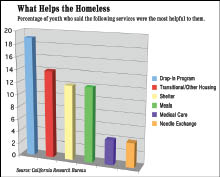California Research Bureau
Available at http://www.library.ca.gov/crb/08/08-004.pdf
 |
Although estimates vary widely, the most recent data provided to Congress suggest that, at any given time, between 1.8 million and 2.1 million youth ages 12 to 24 have been homeless for a year.
The absence of more specific numbers underscores how little we know about this at-risk population.
In an inspired effort to find out more, the California Homeless Youth Project – a research and policy initiative of the California Research Bureau – and the California Council on Youth Relations enlisted help from more than 40 homeless or formerly homeless young people to serve as surveyors and researchers. The effort was funded by The California Wellness Foundation. Recruited through youth-serving agencies around the state, the youths were paid to work with an adult research team to develop a research agenda and initial survey questionnaire, administer the survey and adapt the questionnaire after receiving feedback from respondents.
The youth researchers collected tape-recorded survey responses from the “hardest to reach and least studied populations – those who sleep on the streets or in cars, squat in abandoned buildings, or ‘couch surf,’ ” according to the report. They completed 208 “valid” interviews in 28 cities.
The comprehensive report delves into nearly every aspect of the teens’ lives. Many of the questions were open-ended, inviting thoughtful, insightful and heartfelt responses. In addition to doing an excellent job of discussing and graphically displaying data from the surveys, the authors include hundreds of quotes from respondents and punctuate the report with stark photos of homeless youths.
Major findings include:
Trajectories into Homelessness: The overwhelming majority of youth said they were forced to leave their homes by their parents or because of abuse or family conflict. Forty percent said their housing had been “unstable” for one to four years. More than 50 percent said they felt less safe since leaving home, but nearly 40 percent said they felt safer.
Life on the Street: Thirty percent of those surveyed had spent the previous night outside, on the street, or in a vacant building or vehicle. Nearly 40 percent reported income from regular or temporary work. While 10 percent felt there was nothing good in their lives, 30 percent cited friends and children, and one-quarter cited their own internal strength to survive as a positive factor. Most youth said the public perceived them negatively – as lazy, worthless troublemakers.
Interactions with Law Enforcement: Three out of four respondents reported regular negative interactions with police, including daily harassment and being ticketed. Not a single youth reported turning to police for assistance when victimized.
Education and Aspirations: Most of the youths who were not attending school cited reasons associated with homelessness, such as not being able to shower regularly. Most also said they would return to school if they could. More than 90 percent identified specific career goals. Forty percent said they believed they will be working five years from now, 35 percent said they will be in homes of their own, and 16 percent said they believed they will have attended or graduated from college.
Mental Health: More than two-thirds of the youth said they were mentally healthy, judging by their own positive attributes and ability to function. However, more than 60 percent had received mental health services. Of the one-fifth who said they were not mentally healthy, 20 percent cited trauma as the cause.
Networks of Support and Social Connectedness: Nearly 45 percent of the respondents said they relied on their friends for support, while 28 percent cited a family member. Only 13 percent included a service provider in a list of their top three sources of support. Nearly 60 percent said they provided support to friends or family members, including their own children.
Helping Hands: The three services that homeless youth reported using the most were meals (44 percent), shelters (33 percent) and drop-in programs (32 percent). Only 17 percent reported using case management services. Close to half the youth reported having an experience that made them reluctant to visit a service provider a second time.
Given the opportunity to voice their ideas for policy changes, the youth said they would like the government to “help them meet their survival needs and … stop criminalizing their own efforts to do so,” according to the report.
























